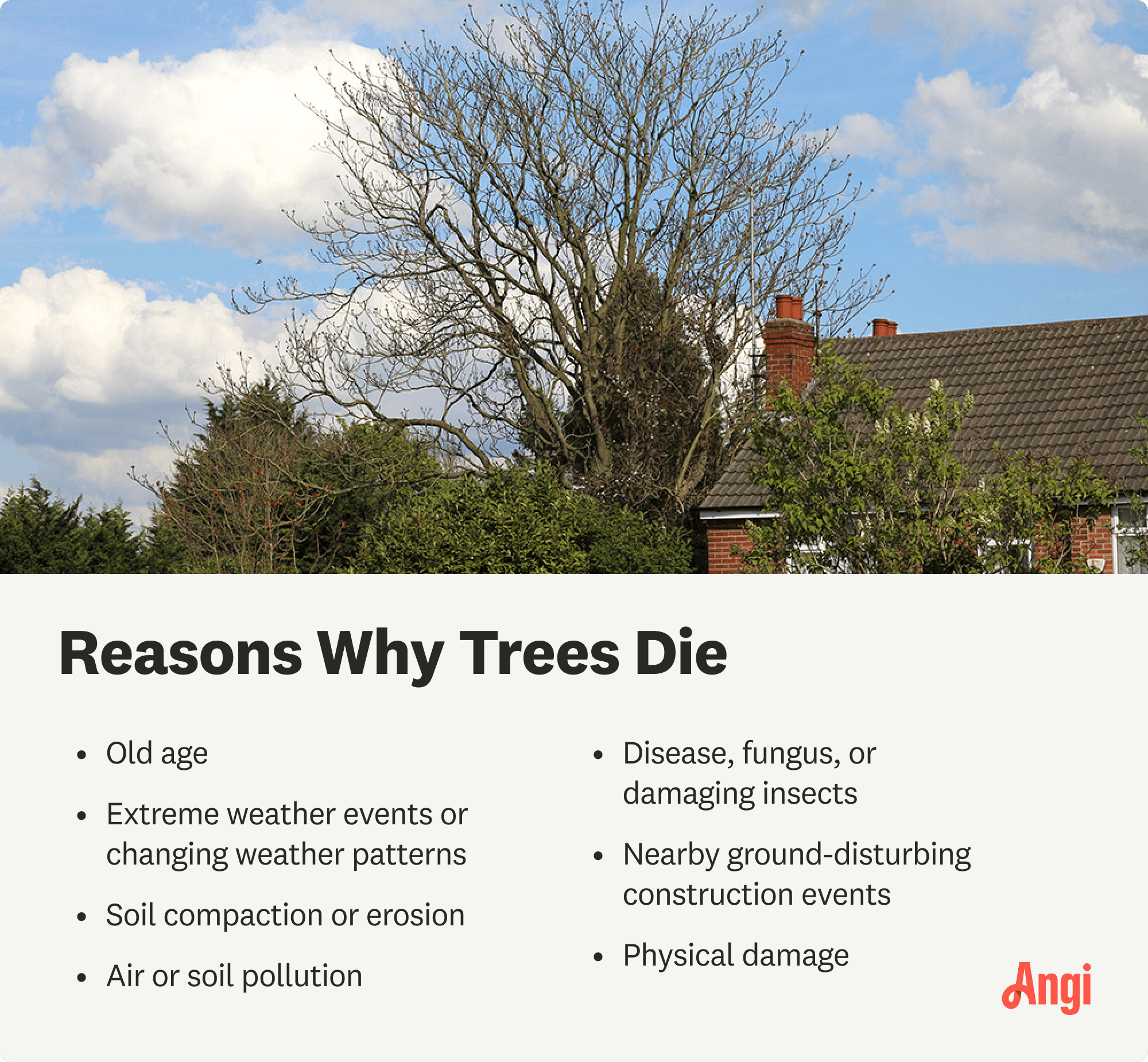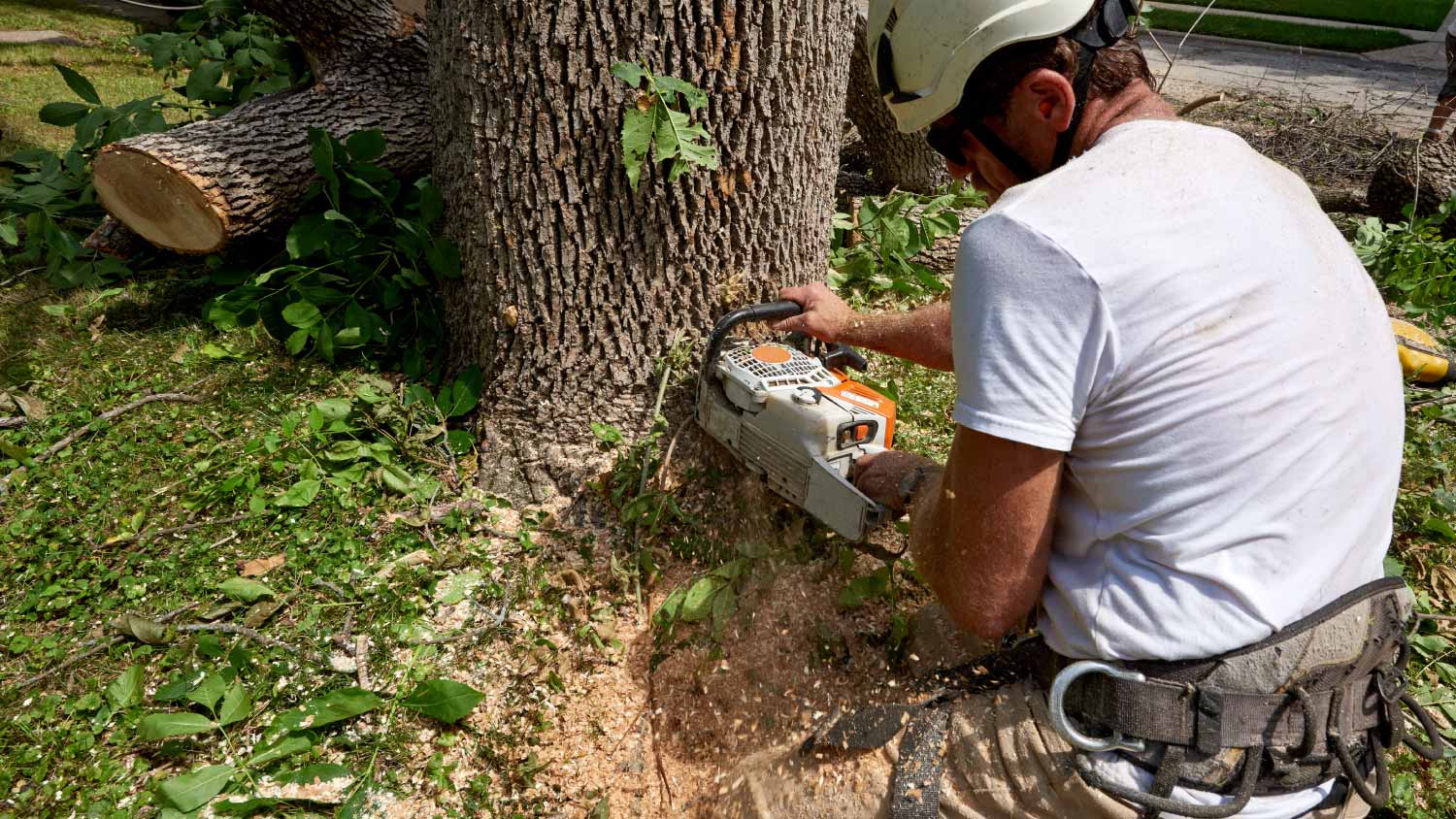What to Do With a Dead Tree: 6 Options
Find a way to get rid of dead trees quickly


Dead trees don’t belong in your yard—they can become a hazard to other landscaping features and, let’s face it, an eyesore. So, what should you do with a dead tree? Taking the dead tree down is a vital step, but after that you have many options. Whether you want to start a wood-oriented project or get rid of the tree entirely, it’s time to pick a path. Let’s go over how to find your tree’s final destination.

1. Reuse Tree Branches and Logs in Landscaping
Instead of letting leftover trunk sections and tree limbs take up space in your trash or yard bins, consider repurposing them for a space-saving and environmentally-friendly alternative. Consider hiring a local tree maintenance service to help you remove and repurpose parts of your dead tree.
Use Tree Branches as Rustic Decor
For a rustic theme, you can cut, strip, and sand attractive branches to use as wall decorations, borders in landscaping, and more. Give larger trunks the same treatment and use them as tables or bench seats.
Create Small Decorative Pieces
Use woodworking skills to transform smaller tree branches or trunk slices into display platters, candleholders, book ends, and other indoor-friendly pieces for a perfect cabin style.
Turn It Into a Garden Feature
A dead tree can be transformed into a unique garden feature. You can carve it into a sculpture, hang bird feeders or lanterns from its branches, or use it as a trellis for climbing plants.
Build a Fence, Gate, or Wall
You can use dead tree limbs to create natural fences and privacy walls that both you and the local wildlife will enjoy. You can also fashion tree limbs into latticework, gates, or mounts. Positioning the branches in a tight weave can help hide a property eyesore, such as an outdoor AC unit.
2. Hire a Company to Mill a Tree for Lumber

If your dead tree is a large specimen and still has a lot of healthy wood, consider looking for a local tree service company that can mill the tree professionally to produce lumber you can use for projects. If you have experience in woodworking or turning lumber into art, this task could provide materials for years of fun DIY projects.
The milling service usually charges a labor fee per hour, plus a fee per board foot or “bf” that can range from $0.15 to several dollars or more, depending on the project. Keep in mind you may have to transport the wood yourself for milling.
3. Leave the Tree In Nature for a Wildlife
If you don’t want to use the dead tree for landscaping or projects, you can cut it down, transport it to a secluded spot, and let nature do its work. This option has more benefits than you may expect: When tree parts naturally decompose, they provide nutrients for the soil, safe spots for local wildlife, and a nurturing place for new growth. However, it’s not a process you want in your backyard, so you’ll need to find a local grove or forest where it can decompose legally and peacefully.
4. Mulch the Tree For Future Landscaping
If the tree is still in good condition and free of disease, you can arrange to hire a professional tree service to turn it into mulch and use it for landscaping. That pile of mulch can help insulate plants over winter, brighten up garden paths or flowerbeds, and serve as an airy layer of protection around trees and shrubs.
5. Remove the Tree
If the tree is posing a safety hazard due to its size or proximity to your home and other structures, it’s best to hire a local tree removal professional to remove it. Dead trees can become brittle and unstable, making DIY removal dangerous, so you should always hire a certified pro for this project.
6. Grind or Remove the Stump
If you’ve removed the tree but still have a stump left behind, consider stump grinding to remove it entirely. This process helps eliminate the stump from the surface, preventing it from becoming a tripping hazard or attracting pests. However, it can be dangerous to use a stump grinder without previous experience, so consider hiring a tree or stump removal professional for this task.
Frequently Asked Questions
Once you confirm a tree is dead, you should remove it. Dead trees eventually fall, and larger trees in particular can cause damage to rooftops, fencing, flowers, and other objects. As we mentioned, letting decayed wood stay in your yard also invites risks to the surrounding landscaping and vegetation.
It could be anywhere from weeks to years for a dead tree to fall. A dead tree falls based on its weight, how it leans, the state of its roots, the state of decay, and what local windstorms are like, among other factors. Since it’s hard to predict the fall’s timing, it’s important to cut down a dead tree quickly and avoid any unpleasant surprises.
We recommended removing the tree stump because it can create many of the same problems as a dead, decaying tree. Those stumps can rot over time, creating an attraction for bugs, fungi, and other unwelcome yard guests.
If your tree specialist says that a hardwood tree is in excellent condition, you may be able to use the stump as a decoration for years to come. However, it’s still important to keep an eye on it, and arrange to remove the stump if it starts to show significant signs of decay.
Your neighbor is not in a good position to know if your trees are truly dead or pose any kind of danger. That’s why hiring an arborist or tree service expert can be such an important part of the process. If the trees are still alive and don’t pose any threat, you’re in the clear (but you may want to document and photograph everything in case events turn sour down the road).
But if a tree is visibly dead and near the property line, you should remove it to be safe. If a dead tree falls on a neighbor’s property, they may have grounds to sue for negligence. If any branches on trees have died, it’s a good idea to cut them back for similar reasons.




- When To Cut Down A Tree: 13 Ways To Tell
- Can You Get A Tree Removed For Free? Not Usually
- How to Save a Dying Tree: 8 Tips to Try
- Who Should I Call for Tree Branch Removal?
- How to Remove a Tree Yourself
- Who Do You Call To Clear Away Dead Trees?
- Is My Tree Dead or Dormant?
- How to Tell if a Tree Is Going to Fall: 5 Warning Signs to Look Out For
- How to Straighten a Tree That’s Leaning in Your Yard
- How to Cut Down a Tree Safely










